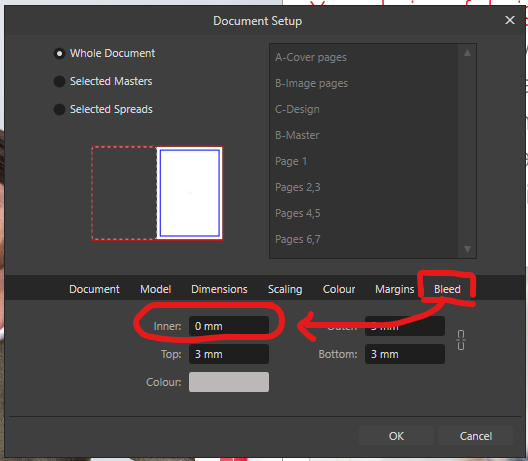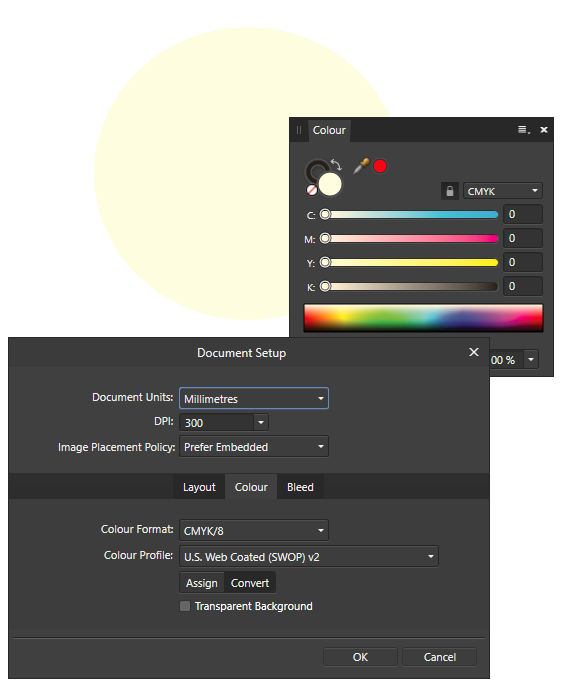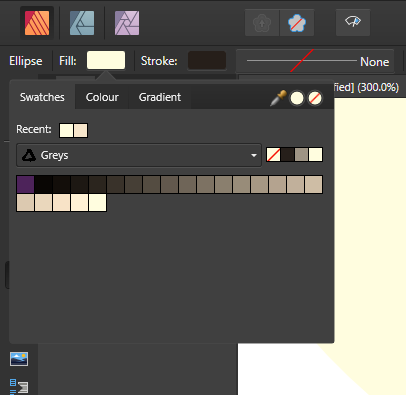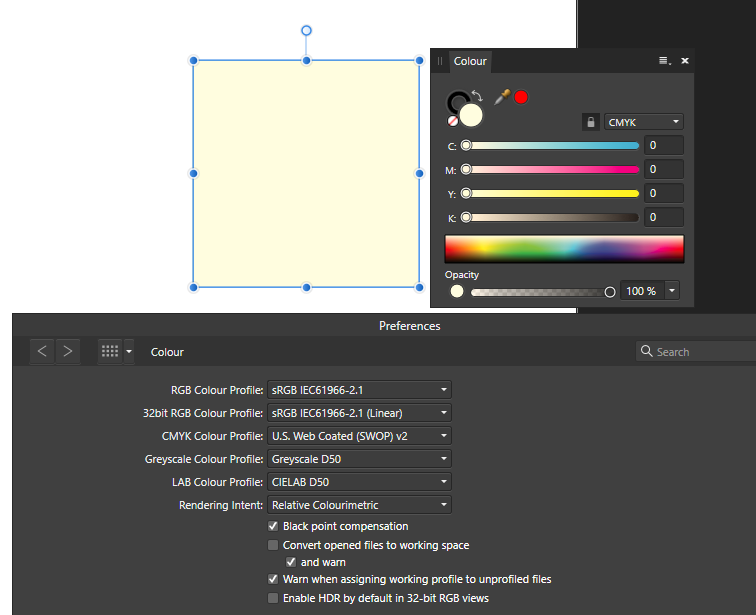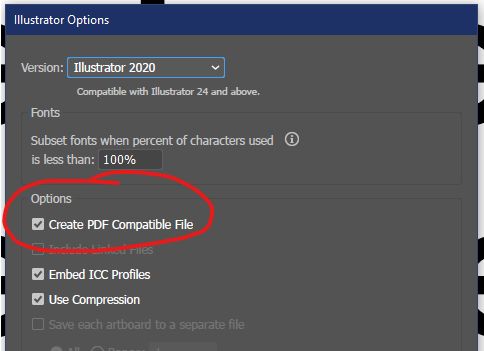-
Posts
269 -
Joined
-
Last visited
Everything posted by Stephen_H
-
Yup, I've never had any problems in the final printed pieces - I'm just a bit old school. We used to give the printers artwork that was perfect in every respect and I still like handing over artwork that makes my printer raise his eyebrows in surprise and appreciation, rather than have their in-house lacky rework my stuff in Corel Draw to force it to suit their systems.
-
Okay, this is an issue I have had for 30 years going riht back to Quark Express 3 - I've just never thought to ask how everyone else gets around it. When I design a brochure, I work in spreads (as I should). I place an image on the left page up against the spine. This image does not extend over to the right hand page. When export the single pages as PDFs with 3mm bleed, I end up with 3mm of the picture from the left page appearing in the bleed of the right hand page. (I've attached a screenshot of the extra content in my bleed. This creates several problems... 1 - The bleed on the right hand page is now ruined (The point of bleed is to give a little wiggle room for the printer to align/cut) 2 - The image of the left hand page never extended past the spine so it does not appear in its bleed. (Also ruining the bleed by not using it) How is everyone else dealing with this problem? Is there a setting that allows me to exclude content on other pages from my bleed? In years gone by, I was required by printers to do full pagination and deliver final artwork as spreads which never had this problem. Now, printers want the artwork as single pages for their software to do the pagination. I used to separate every page out of its spread, manually add the bleed etc producing clean pages using bleed to its fullest. This is enormously laborious to do and doesn't work when images cross the spine.
-

Make Blend tool
Stephen_H replied to tbhockey's topic in Pre-V2 Archive of Affinity on Desktop Questions (macOS and Windows)
Yup. Blends + gradient mesh is still the best way to create a realistic shadow under a 3D object. It takes lots of very difficult hand painting with a soft airbrush to acheive this. -

Affinity products for Linux
Stephen_H replied to a topic in Feedback for the V1 Affinity Suite of Products
Ahhh... remember the days of Windows NT? -

Affinity products for Linux
Stephen_H replied to a topic in Feedback for the V1 Affinity Suite of Products
For years I've been wanting to move off Windows and onto Linux, but without pro apps for a graphic designer, I can't. I understand the chicken and egg situation - No designers using Linux because there's no apps for them. There are no apps for them because all the graphic designers are using Windows/Mac. I truely do not care what OS I'm using. I started on Macs and loved the interface, but moved to Windows because Mac's hardware stopped giving me ports and storage. (When you live in Africa, we can't just fit in with first world thinking of "everything in the cloud" and just connect wirelessly. We barely have electricity, let alone always-on highsleed, affordable broadband) It was a hardware decision not an OS preference. I support Affinity because I've always been a sucker for the under dog. It's as much of a poke in Adobe's eye as it is a better financial choice. (I suspect that's the case for many Affinity users). I apply the same attitude to Linux. It's the under dog and want to support it. I don't even care what distro I have to use. If Affinity announced that their apps only ran on one speciffic Linux distro, eg: Mint KDE, I would choose that distro as my Linux OS. If they chose Manjaro or Suse... done. Side note... I'd support a kickstarter fund - even if it's to guage the financial viability of Linux support. -
Walt... you're a genius. Your answer sent me in the right direction. I discovered this problem wasn't limited to Publisher - but involved displaying all imagery through Windows (Except for PDFs, go figure). It turns out that I only get this problem when I have a second monitor plugged in with the display setting on "Second Screen Only". I change it to Duplicate screen" and everything is fine. I'm guessing my Dell monitor is forcing an uneccessary colour display profile to be used. So this turns out to be a Windows issue instead of a Publisher issue. This is new and has never happened before (I know, I use "Second Screen" every day at work) Thank you everyone who helped me solve this puzzle.
-
Hi. It's in every document I open - new and old. It also doesn't matter what colour format I choose for the document... CMYK, RGB, or even Greyscale. The display is identical. It even displays this creamy colour in my swatch palettes. Even placed images get changed. (This example of a white bottle actually has a pure white background) This problem is definitely global and not limited to a single document. I'm attaching the document as well as the exported PDF which comes out fine. Test.afpub Test.pdf
-
Help. Publisher on Windows is suddenly displaying all objects with a warm, yellow shift. It's so bad, that pure white appears like a 30% yellow. The artboard is pure white, so I know it's not my monitor. All I can imagine is that it's a colour profile issue that is forcing objects to display differently on screen. If I make a white object (like my screenshot), it appears cream on screen, but if I print it to my laser printer, I get a blank page. Same thing if I export a PDF. My white object appears white. This means that white is still white, it's a representation on screen. This screems colour profiles to me, but everything is set to factory defaults. It also doesn't matter if I use a CMYK, RGB or even Greyscale documents. They all display white as cream. Yesterday, I registered my app/device on my Affinity account. Is it possible that registration has forced new settings into my app?
-
Quite disappointing that there is no comment in this thread from an Affinity employee. It would be nice to hear from someone in the know who can tell us what's going on with these basics. IFor example, if they could just tell us that their software is aimed at UX & webdesigners, but also supports print designers, then we'd understand a lot of these "over sights". Do they use experienced designers to guide their development, and if they do, are they print designers or web designers, and why they don't mind working with these short commings? Are there any plans to correct/complete existing features, or are they just moving on with adding new features. What is their view on professional print production? (eg: Do they think a professional workflow is placing RGB PNGs into a doc, then convert to CMYK at export and hope and pray that everything comes out okay? ...like in one of their video launch demos.) If we know their intent, we can probably throw away a whole bunch of these issues we've been discussing and stop getting frustrated when they seem to be ignoring our cries.
- 32 replies
-
- separations
- proofing
- (and 8 more)
-

Has the price changed?
Stephen_H replied to Stephen_H's topic in Customer Service, Accounts and Purchasing
So Apple Store adds a commission on it, and the Windows version from your store also goes up? That doesn't seem fair that the "Apple Tax" should affect all your products. -
I really don't understand the problem here. We have a feature roadmap for version 1. All updates for these features will be free. What ever version you have purchased will receive all the feature promised. Version 2 has not even been discussed so we have no clue what version 2 is going to look like or what features it will have. When it rolls around and we get it presented to us, I'm sure it will be worth every cent. If it isn't, continue using the version you currently have (which you own for ever).
-
I've just noticed that the price of the 3 applications are R999 and I'm sure they used to be R799. Since my currency's exchange rate to the US Dollar has not drastically changed, I can only assume the Dollar price has changed. Even if I factor my country's local tax (VAT) of 15% into the price, I can't get it to the current displayed price. If I use the sum: US Dollar price x Exchange rate + 15% VAT = my local price in South African Rands ($49 x 15) x 1.15 = R845 This is very close to my memory of R799 and this can be due to a few cents in the exchange rate. Without VAT, I'm equally close. ($59 x 15) x 1.15 = R1017 This is close to the current displayed price. Are the Affinity apps $49 or $59? Note: A quick Google search revealed Photo selling for $45 on B&H, and all review sites still list it as $49. Is my country (or other countries) getting penalized? Are there separate US and an international prices? It feels wrong that I'm being presented with a 20% markup on the advertised price.
-

Better Layers Panel
Stephen_H replied to betachromatic's topic in Feedback for Affinity Designer V1 on Desktop
I would argue that we don't actually have a Layers Panel at all. It should be called the Objects Panel. The closest we have to layers are the way groups are displayed. I miss being able to lock and hide layers, and limit an object's position (Move to back, is limited to the bottom of the layer, not the whole document) Unfortunately, pages are also treated as objects. More specifically, pages are like permanent groups, so it would be nice to have a proper Pages Panel as well. Or even just a pop up pages window like tabs are managed. We need the Layers Panel to be re-thought and get it on the right path before we start throwing more features at it. I suggest we have a very simple Layers Panel that just shows the layers and not the objects within it (like InDesign or Quark Xpress). Then we rename the Layers Panel to Objects Panel. The objects displayed in this panel are limited to the layer you have selected. The Objects Panel won't get out of control and we have proper layers for object management. If you don't like/need layers, then just have one layer and keep using the objects Panel as you are currently. No great change to the current work flow and we now have real layer management. -

Free transform
Stephen_H replied to abra100pro's topic in Feedback for Affinity Designer V1 on Desktop
I also want this feature. (Though can this not be [mostly] achieved with the perspective tool? Free transform/Distort is nothing more than just adding 1 and 2 point perspective) As for the second point raised in this discussion... we should make better use of tags when we open a discussion. This will group associated post topics together and make future searches easier and more relevant. -
As a quick solution, what I'd advise to Affinity is to not try and integrate all features into their current apps. They should make them standalone utilities. A standalone tracing app using opensource code from Inkscape, just with an Affinity "skin" applied to it that exports Affinity native files, would get the job done fine. Affinity could even charge $5 for it rather than adding it as a feature for free which will frustrate everyone with its slow delivery and impact on earnings. If you think it's important, I'm sure you'd happily pay a measly $5 for it. Instead we wait patiently for its turn to come around in the features roadmap where a developer is going to lovingly integrate it into Designer and probably spends months troubleshooting it because it's conflicting with something in Publisher due to the shared file formats. I think Adobe has already done this: "Save for web", "Filter gallery", "Liquify mode" and "Raw photo developer"... all of which feel like standalone apps with their own interfaces. They feel like they were purchased from third parties and shoe-horned into Photoshop. Years later, they still sit on the fringes and no-one seems to have noticed, or even seems to care. Coel Draw definitely did this. It was called Corel Trace and was an app, not a feature in Draw. I think a range of "Pro level utilities" would be a great money-spinner for Affinity while we wait for v2 of everything to be released. I'd be willing to pay $50 just for an app that will allow me to proof a repro-ready PDF. Just give me the ability to view each colour channel individually to confirm over printing, knockout, spot colours, colour mode. Add listing image resolution, profiles, dimensions, PDF versions etc and I'd trust ALL repro files coming out of Affinities apps. This wouldn't be something all users would need or want, so make it an optional extra.
- 473 replies
-
- designer
- vector conversion
-
(and 1 more)
Tagged with:
-
I think the point is that most of the 334 posts in this discussion, is that we want Affinity Designer to be that option. We don't want to turn to other apps. We should be turning from Inkscape to Aff Designer, not the other way around. What if all Aff Designer users downloaded the free, opensource Inkscape just to trace their scans, and then discover that Inkscape is a better app? Simple rule of business: Never send your clients to your opposition, because they might not come back...
- 473 replies
-
- designer
- vector conversion
-
(and 1 more)
Tagged with:
-

Feature request: Custom Arrow Heads
Stephen_H replied to sfriedberg's topic in Feedback for Affinity Designer V1 on Desktop
Oh dear. Don't hold your breath here. Arrow heads was a feature that we called for right from the start, and it took many, many, many years for them to finally appear. And now you go and ask for "custom" arrow heads? Tsk, tsk. What are we going to do with you a cowboy like you? 🤠 -
Ah, thanks for the insight. The comment about their own legacy software having features that are missing caught me by surprise. I have watched their roadmap, but I now take it bit a bit of salt because features on it have taken incredibly long to implement (The "arrow heads" saga comes to mind) I think they should take a break from adding new features, correct and refine what they have and then launch version 2. It should also carry a cost to upgrade. I'm worried that Affinity's rate of development is slowing because of financial constraints. My copy of Designer and Photo were both purchased in 2014 when they were launched. I still get the benefit of the upgrades, but Affinity has received no financial compensation from me since. While I can expect to own my software for ever, I can't expect new features and free updates for life.
- 32 replies
-
- separations
- proofing
- (and 8 more)
-

Illustrator Import Loses Content
Stephen_H replied to Ken Kopecky's topic in Feedback for Affinity Designer V1 on Desktop
Just make sure your turn on "Create PDF compatible file" when you save your Illustrator files or else it might not import correctly. It is on by default, but you never know... -

Illustrator Import Loses Content
Stephen_H replied to Ken Kopecky's topic in Feedback for Affinity Designer V1 on Desktop
You will also find that anything sitting off the artboard will also not import. Make sure it's placed on a page/artboard, otherwise it gets ignored. -
That's interesting. Their own legacy software has this? Did they really throw everything away and build these apps completely from the ground up? I think this is part of the frustration many feel... basics are in opensource software, AND their own legacy software. This means the code to do this exists and is available to Affinity developers. This now feels like a decision to intentionally leave these features out. I really hope this is not the case.
- 32 replies
-
- separations
- proofing
- (and 8 more)
-
I've just tried this. Rotating an object with while holding down the Control key and/or the Alt key doesn't make any difference to me. See my demo screencast: 2020-11-04-10-44-54.avi
- 32 replies
-
- separations
- proofing
- (and 8 more)
-
Agreed. JPEG export preview is essential. At the very least, it's logical. The cutting edge features I vaguely refer to are things like live vector brush strokes, advanced slice exporting, scalable objects, live shapes, live corners... things like this. Nice to have, good to brag about, but not essential. The problem is this... we buy the app for these features that stand out in a comparesson chart against Illustrator, but then we find out that Designer only plays lip service to the basics. eg: Affinity's apps are part of a very small groups of designer apps that support a CMYK work flow which is essential to print designers. Working in RGB with the option to export as a CMYK PDF is not the same (see Pixelmator for this issue). However, when you actually start working in Designer, you quickly learn that while its color management/workflow is is genuine, it's not mature and robust. Affinity apps remain on my computer more as novelties than my primary work tools because of this. I support Affinity because I'm hopeful of a future, but right now, I just can't let Adobe go.
- 32 replies
-
- separations
- proofing
- (and 8 more)
-
Ah... use the Control key instead of Alt key... fantastic. Thanks for that tip. It just feels unintuitive because I come from an Apple background where Alt is always duplicate. I think of Control as a command key to be used with another key, not with a curser action. Thanks for this. It makes a BIG difference.
- 32 replies
-
- separations
- proofing
- (and 8 more)


